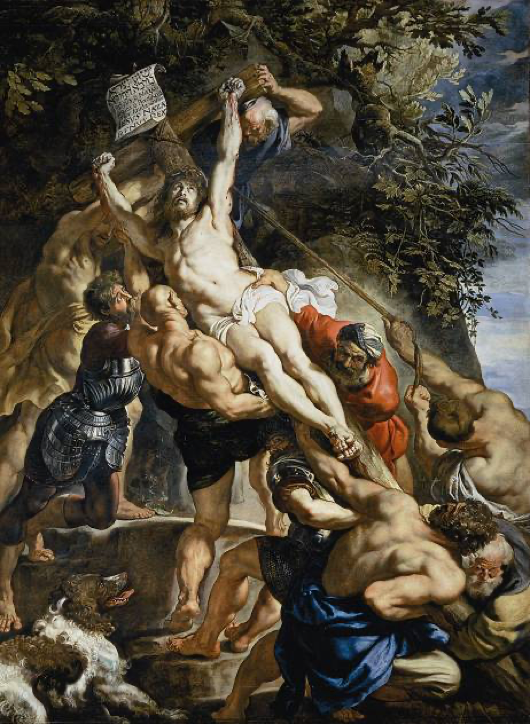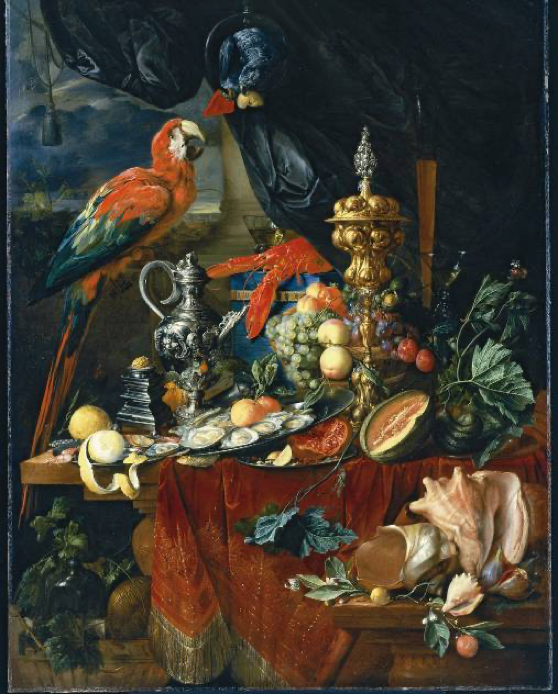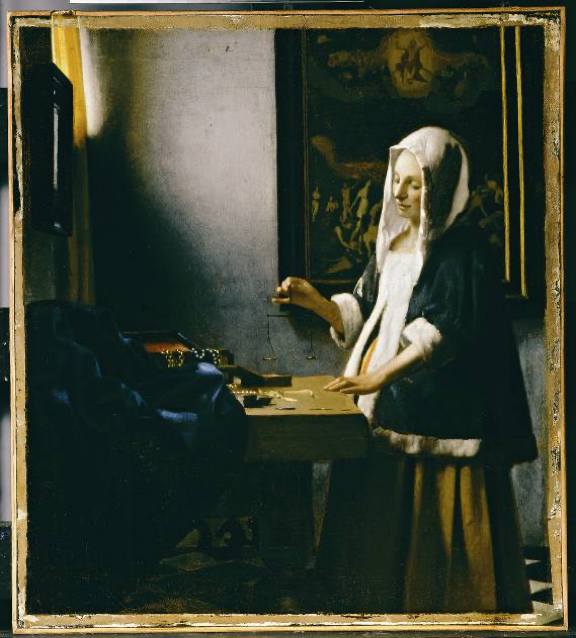10: The Baroque Period in Northern Europe
( \newcommand{\kernel}{\mathrm{null}\,}\)
Introduction
Caravaggio’s paintings demonstrating theatricality, dramatic lighting, and a sense of realism in secular and religious paintings is a major influence on painters across western Europe. Renaissance artists such as Michelangelo, Raphael, and Leonardo de Vinci continue to inspire and contribute to the evolution of European painting. We see this in the works of the great northern painter Peter Paul Rubens. Rubens, much like Raphael and da Vinci has success both in art and politics. He attains wealth, prosperity, and a comfortable living through his social status and talents. He travels to Rome and studies the paintings on the walls and ceiling of the Sistine Chapel. His drawings from this time are still preserved and remind us of the rigorous academic studies coming into the art schools at this time.
The Raising of the Cross closely resembles the style and rigorous movement Michelangelo creates in the Sistine Chapel. The figures in Ruben’s painting are muscular and rugged. The action is dramatic, and the composition is theatrical, very much in line with the Baroque art movement. An earlier sketch helps to show the evolution of this visual concept from a more sprawling landscape to a more focused and tighter composition. The color palette is rich and vibrant with elements that resemble the works of high Renaissance painters. The action and power of the imagery is what is new and unique to the Baroque. This moment in time is captured in a Counter Reformation painting that draws us into the scene through the angle of Christ on the cross. We, the viewers, are placed right at the bottom of the cross and become part of the painting. The visual space is both in diagonal recession, creating a dynamic composition, as well as space coming out towards us with the figure to the lower right. This is a modified version of Caravaggio’s tenebristic paintings since the palette is brighter and the space deeper.
https://www.nga.gov/collection/art-object-page.46159.html

The Raising of the Cross, Peter Paul Rubens 1610-1611

Sketch for The Raising of the Cross Rubens 1609

Drawing after Michelangelo’s Ignudi from the Sistine Chapel Rubens 1601-1602


Portrait of Marchesa Spinola Doria, Rubens 1606 Marie de ‘Medici, Queen of France, Landing in Marseilles Rubens 1622-1625
Rubens excels at painting textures and fabrics as well as images of architecture. His visual storytelling is striking and effective. Merging mythological imagery with a painting of pure propaganda, Marie de ‘Medici, Queen of France, Landing in Marseilles places us, the viewer at ocean level looking up at the new queen as she ceremoniously arrives at Marseilles. An ocean voyage at that time was an arduous and long adventure with few conveniences. The political turmoil that will follow Marie de ‘Medici are also factors not present in this elaborate and luxuriously optimistic painting.

Garden of Love, Rubens 1638
The Garden of Love presents a secular image of the fine life of aristocrats living in Holland at this time. The women are dressed in the finest garments and are, as many of Rubens’ women, full-bodied. The term Rubenesque refers to women who are well endowed and quite fleshy. The painting is a celebration of love and romance, sentimental and humorous. The setting has references to the classical past with a fountain circulating water from a porpoise’s mouth and the breast of a nude female. Cupids encourage romance by pushing one female dancer towards her male partner and shooting love arrows into the group. They actively engage in the folly by flying around in twisted and contorted arial displays. The cupids frame the painting in the upper left and right and direct our eyes to the lower center where the group has gathered.
https://www.metmuseum.org/art/collection/search/334653

Portrait of Charles I Hunting, Anthony van Dyck 1635
Charles I is painted as the confident and powerful ruler of the lands upon which he stands. Even the horse bows down to this king. The stance will be repeated by Louis XIV, the Sun King, in his royal portrait as these two rival nations vie for world supremacy. Unfortunately, Charles I will be accused of treason and beheaded leading to an unstable period for England.
https://www.nationaltrustcollections.org.uk/object/593112
https://artuk.org/discover/artworks/charles-i-16001649-in-the-hunting-field-100958

Market Stall, Frans Snyders 1614
Frans Snyders paints a delightful and humorous work during a time when merchants were allowed to set up stalls in their local towns for selling their crops and other products. This overblown still-life is an overwhelming collection of slaughtered animals from the countryside presented in a haphazard display. Greeting the potential buyer, the seller raises his hat and is proud to show off his items. However, behind the bravado is more sinister elements coming into play. The black cat eyes the fighting cocks, the birds attempt to fly away, and the boy is pick-pocketing the money from the man’s trousers. Brilliantly painted in realistic detail, the painting is a reminder of both the sin of gluttony and excess, and also of restraint and responsibility to self and community.
https://www.artic.edu/artworks/62042/still-life-with-dead-game-fruits-and-vegetables-in-a-market

Still Life with Parrots, Jan de Heem 1640s
The Vikings ruled the seas in the Medieval Period and the Dutch continue the seafaring ways by becoming major importers of exotic goods from around the globe. Monies poor into the Netherlands and this, combined with a pragmatic sensibility, leads to the development of painting genre reflective of both. Still-lifes, genre paintings, and market scenes begin to be more common and also affordable to the wealthier middle class art buyers. The still-lifes often include a narrative built around both prosperity and biblical or general life lessons. It is an interesting juxtaposition of these two themes that repeats in the paintings. Many paintings will include themes around the transient nature of life. These paintings are referred to as vanitas art and become popular in Holland at this time. Still Life with Parrots, by Jan de Heem, is a good example of the luxuries and exotic goods now appearing in Holland. Paintings like these are more affordable and smaller in scale than the larger commissioned paintings such as group paintings of civic guards. A new market for smaller, affordable paintings grows in the Netherlands and painters are able to sell openly to the emerging middle class. This was not the case in Renaissance Italy where an artist needed to be aligned with a patron.

Banquet of the Officers of the St. George Civic Guard, Frans Hals 1616

Married Couple in a Garden, Frans Hals 1622

The Jolly Toper, Frans Hals 1628-1630
Frans Hals is considered a painter’s painter since his fresh and loose brushstrokes are often visible in his paintings. He has much success capturing the essence of the sitter’s expression or the gesture and movement of the individual. Painting large commissions such as the Banquet of the Officers of the St. George Civic Guard. His painting, Married Couple in a Garden, breaks with the formal paintings emphasizing wealth and power, and instead presents a painting that emphasizes happiness, heartfelt love, and a marriage of equality. The husband places his hand over his heart representing the love he feels for his wife, while his wife casually leans on her husband with a little playful smirk. It is a refreshing painting that balances wealth and happiness. The pair leans up against a tree connecting them with the land they own and making the painting feel even more natural. The Jolly Toper also shows a moment in time where Hals captures the feeling, expression, and happy mood of the individual.

Self-Portrait, Judith Leyster 1630

Young Flute Player, Judith Leyster 1630-1635
Judith Leyster had to create a painting to submit to the Guild of Saint Luke to teach professionally and to make a living. Her Self Portrait is believed to be the art she submitted to the jury. If so, it completes three tasks. One, it was successful in granting her the right and privilege to pursue art as a profession and to help support her family financially. Second, it demonstrated she can paint portraiture. Third, it shows and advertises, that she can paint genre paintings. It was a very clever way to gain notoriety by presenting herself this way. Young Flute Player is a great example of her genre painting style.
https://www.nga.gov/collection/artist-info.1485.html
https://nmwa.org/art/artists/judith-leyster/
https://www.nga.gov/features/slideshows/judith-leyster.html
https://www.khanacademy.org/humanities/renaissance-reformation/baroque-art1/holland/v/leyster-self
https://www.youtube.com/watch?v=6O52DIb2R30

The Night Watch (Company of Captain Frans Banning Cocq) Rembrandt van Rijn 1642
It is believed that more is written about Rembrandt than any other painter. Rembrandt paints in a combination of traditional Northern techniques infused with the innovations of Caravaggio. We see in his work The Night Watch a unique presentation of the tradition civic guard paintings. Here, Rembrandt places the soldiers in a composition highlighting the hierarchy of the company. The captain is placed at the center, leading the group with his left arm reaching out towards us, the viewer. He is flanked by his next in command whose spear projects out toward us. This space moving out of the picture plane engages us, much as in the paintings by Caravaggio. The setting is very theatrical as is the lighting. A spotlight falls upon the two main leaders as they stride forward. The stage is darkened around them and multilevel creating a three-dimensional setting allowing Rembrandt to paint in each individual member of the company.
https://smarthistory.org/rembrandt-the-night-watch/
https://www.rijksmuseum.nl/en/collection/SK-C-5
https://www.cnn.com/2023/12/19/style/x-rays-lead-rembrandt-the-night-watch-scn/index.html

Self-Portrait, Rembrandt 1658
Rembrandt’s self-portraits are unique amongst artists up to this time in Western art. They give us a glimpse into the painter and his psyche. There are over 80 self-portraits discovered over the years attributed to Rembrandt. Why he produced such a large number is unknown. They do show us how he aged over time, and also demonstrated many of his studio props used for his history and portrait paintings.
https://www.nga.gov/collection/highlights/rembrandt-self-portrait.html
https://www.metmuseum.org/art/collection/search/437397

Woman Holding a Balance, Jan Vermeer 1664

The Love Letter, Jan Vermeer 1665-1668
Vermeer paints softly lighted interior scenes of women at specific moments. Woman Holding a Balance shows a young pregnant woman holding a balance. Her jewelry is out of the box and placed on the table and she gazes down in quiet contemplation. Is she thinking about her past, present or future? Is she concerned about her upcoming delivery? Is she wondering if the scales (judgement) will favor her. The Last Judgement is a painting hanging on the wall next to her, so the household considers the concerns of Christianity and is likely religious. It is an intimate portrait, quiet, and full of mystery.
https://www.nga.gov/collection/art-object-page.1236.html
https://www.nga.gov/collection/highlights/vermeer-woman-holding-a-balance.html
https://smarthistory.org/johannes-vermeer-woman-holding-a-balance/
Vermeer is the subject of a feature film. This is the link to the trailer:


